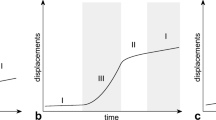Abstract
Based on an analysis of displacement-monitoring data of Xintan landslide, China, it was discovered that the whole stability of large-scale colluvial landslides can be more accurately described by taking the displacement vector angle into account, and the stability trend of a slope can be evaluated and predicted using the displacement vector angle. This paper also further indicates that the monitored deformation vector angle can be divided into sliding deformation vector angle, plastic-deformation vector angle, compressive deformation vector angle and creep deformation vector angle in terms of the displacement properties of the slope. Through the analysis it is found that the displacement vector angle, for which there is no substitute, is an important parameter serving as an explicit criterion for the stability of the slope, and hence its significance in the prediction of landslides. It is also shown that as far as the displacement vector angle is concerned, there are different constituents and features in the different deformation stage of colluvial landslide. On the basis of these and using the principles of statistics, a discussion on the stability of the colluvial slopes is carried out in terms of the monitoring data of F-series points on Xintan slope. The analysis results coincided with the destabilized time and the sliding laws, thus demonstrating that the parameter of the displacement vector angle has to a certain extent, very important significance in the forecasting of landslides.


Similar content being viewed by others
References
Brand EW (1981) Some thoughts on rain-induced slope failure. Proc 10th Int Conf Soil Mech and Found, Engrg London, vol 3, pp 374–376
Chen WF, Chan SW (1984) Upper bound limit analysis of the stability of a seismic-informed earthslope. Int. Symp. on Geotechnical Aspects of Mass and Material Transportation. A.A. Balkema, Bangkok, pp 284–286
Keqiang H (1998) A multilayer slide model and its laws of the accumulative landslides. Proc 8th Int IAEG Congr, 21–25 Sept 1998, Vancouver, Canada. A.A. Balkema, Rotterdam, pp 2259–2261
Keqiang H, Jibao Y (1996) The forecast and prevention of the accumulation formation landslide. Seismic Press, Beijing, pp 33–36
Mair R J (1993) Developments in geotechnical engineering research Application to tunnels and deep excavation. Proc Inst Civ Eng. Heinz Heise, Hannover, pp 30–37
Mazen E (2000) Slope failure in weathered claystone and siltstone. J Geotech Geoenviron Eng Lond 126:787–792
Savage W Z (1986) A model of the plastic flow of landslide. US Geological Survey, Washington. United States Government Printing Office, Washington, pp 21~29
Sijing W (1999) The task and future of the engineering geology. J Eng Geol Beijing7(3):196–198
Xiaonan G (1999) Plastic mechanics of soil. Zhejiang University Press, Hangzhou, pp 282–285
Acknowledgements
Sincere thanks are extended to Prof. Sun Guangzhou, Institute of Geology, Chinese Academy of Science, and Prof. Li Tiehan, China University of Geosciences, Beijing, for supplying the authors with the practical monitoring data of the Xintan slope. Postgraduates Liu Wenjun and Liu Yan did significant work on the monitoring and data analysis for this paper. The authors are indebted to them for their work on this paper.
Author information
Authors and Affiliations
Corresponding author
Rights and permissions
About this article
Cite this article
Keqiang, H., Sijing, W. Constituents and features of displacement vector angle of colluvial landslide. Env Geol 45, 279–285 (2003). https://doi.org/10.1007/s00254-003-0881-3
Received:
Accepted:
Published:
Issue Date:
DOI: https://doi.org/10.1007/s00254-003-0881-3




